Friday 28th September 2018
Buffet breakfast was available from 06.30 a.m. in the Four Seasons large Zafferano Restaurant. At nine o'clock we all met up in Reception to join our various coaches. We were to visit the Gobustan National Park to see the ancient rock art. Our coaches slowly extricated their way south out of the city and I realised that we were retracing our arrival route the previous afternoon when the double-track electrified main line appeared on our right. Our highway, the E119 remained on the seaward side of the railway. We passed the massive LafargeHolcim Cement Plant to our right and various industrial sites to our left.
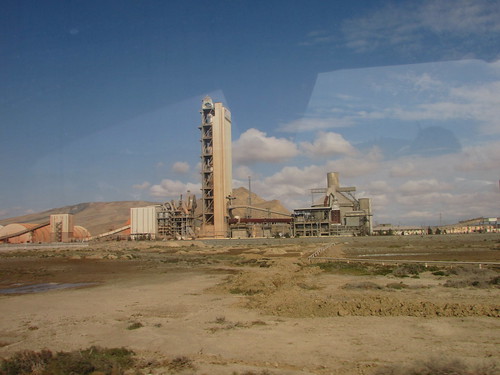
Around Baku: LafargeHolcim Cement Plant Garadagh, viewed from E119 highway.
Periodically, we passed modern police stations. Our guide invited us to recall that the transition from Soviet state to independent nation in the last twenty five years has not been without difficulties and Azerbaijan experienced a repressive and lawless phase. He suggested that the large glazed areas in modern police stations were intended to send the message that the modern police have nothing to hide.
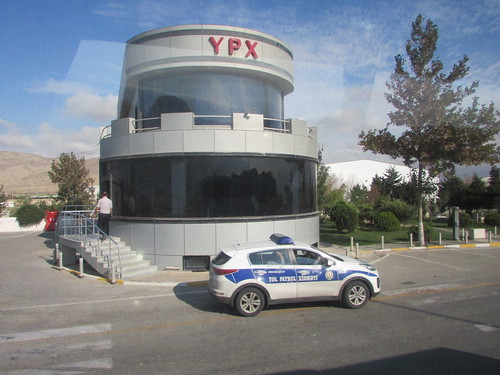
Around Baku: Local Police Station on the E119 Highway.
To reach the Gobustan National Park, now a World Heritage Site, our coach crossed over the railway line on a road bridge and climbed into the muddy-looking foothills I'd first seen the previous afternoon as we arrived at Baku by train. We parked in a car park already busy with cars and coaches. We deferred an exploration of the very modern Visitor Centre until later and our guide led us directly into the rocky area where it seemed that almost every near-vertical cliff has been embellished with primitive carvings depicting scenes from the lives of the prehistoric people who once lived there.
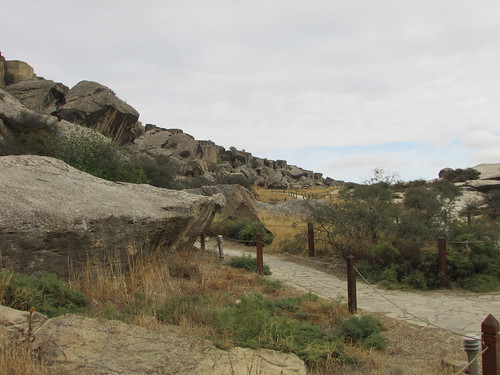
The Rock Carvings of Gobustan National Park, Azerbaijan: One of the footpaths leading through the rocky landscape.
Despite the simplicity of the artworks, I found them evocative and full of vigour. Most are believed to be between 5,000 and 20,000 years old.
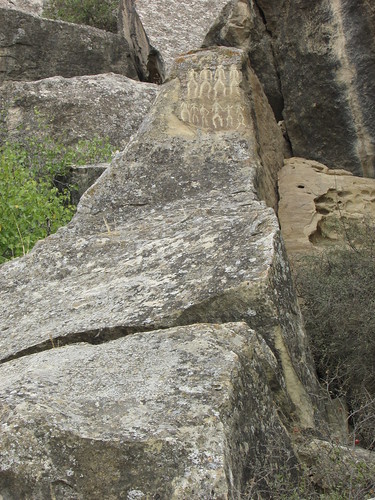
The Rock Carvings of Gobustan National Park, Azerbaijan
I found the carvings of animals particularly interesting but I'm afraid my camera couldn't really do justice to what we we saw.
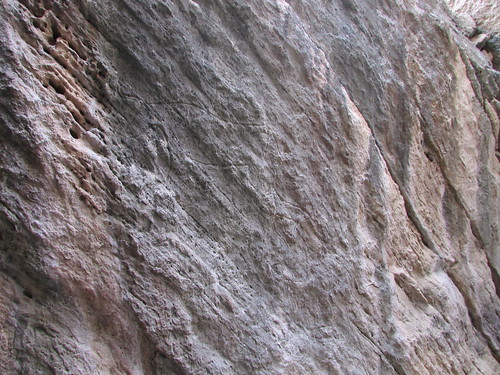
The Rock Carvings of Gobustan National Park: animal images.
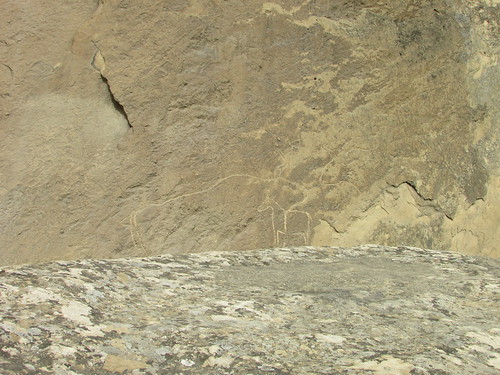
The Rock Carvings of Gobustan National Park: more animal images.
We also saw a 'Gaval Dash' - a naturally-occurring stone which resonates when struck. The example was about three feet long and this type of stone has only been found in the area of Gobustan where I assume the unique geology has produced gaseous inclusions in the stone, giving a strange ringing sound when struck by a smaller stone.

The Rock Carvings of Gobustan National Park, 'Gaval Dash' musical stone viewed from above.
I enjoyed the park itself but the modern visitor centre was rather crowded so we shuffled past the interpretations of prehistoric life fairly quickly. Nearby, there was a representation of a prehistoric village, with a number of full-size mannequin and a series of straw-covered huts. I was amused to discover that one of these huts housed a modern tea vending machine.
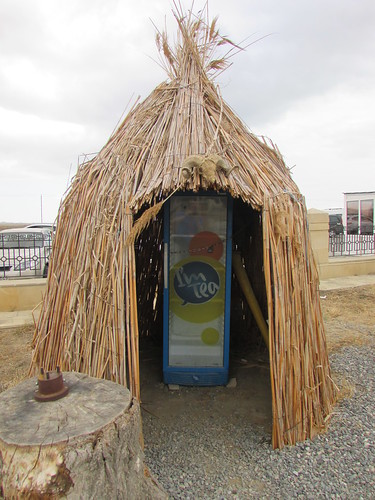
The Rock Carvings of Gobustan National Park: An unexpected tea vending machine!
The elevated site offered good views of the Caspian Sea, and the profusion of offshore oil and gas platforms served as a reminder of Azerbaijan's modern history.
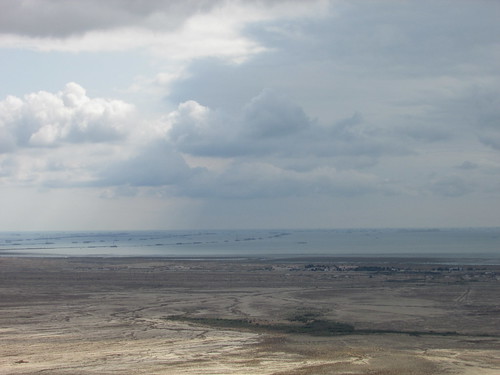
The Caspian Sea viewed from Gobustan National Park, Azerbaijan
Wikipedia has an article about Gobustan National Park here. There's also a rather frantic presentation about the site here which gives some idea of the area. I was rather disappointed that we didn't get to visit one of the mud volcanoes in the area but I suppose it tends to be a rather messy business. The mud is reputed to have medicinal qualities.
We clambered back aboard the buses and drove back to the E119 highway which lead us back towards Baku. In places, we were close to the shore of the Caspian Sea - a rather odd sight with a chain of offshore oil or gas platforms spread across the view, some complete with drilling rigs.
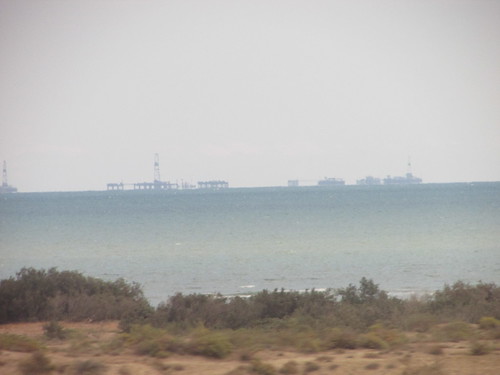
Around Baku, Azerbaijan: The Caspian Sea, with a chain of offshore oil or gas platforms.
We passed the entrance to the ambitious Khazar Islands project - a planned city to be built on around 40 artificial islands which lost funding following a fall in oil price and currently on hold. The artist's impressions on the Design Build Network site here are certainly striking.
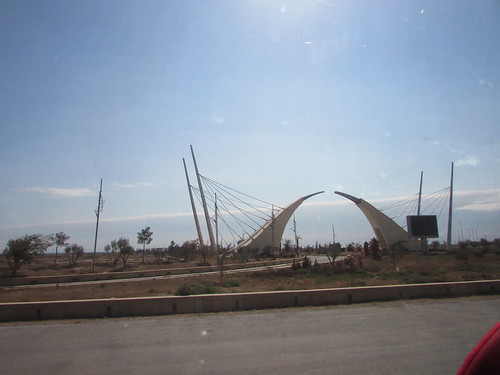
By coach to Baku from Gobustan, Azerbaijan: Entrance to Khazar Island (project currently suspended).
As we approached the city, our guide pointed out a large, informal taxi rank adjacent to a roundabout where passengers negotiate with the waiting drivers.

Around Baku, Azerbaijan: Informal 'taxi rank'.
Passing an area called Shikh Beach, we passed the waiting jack-up offshore rigs moored at a long jetty I'd spotted from the train on our arrival the previous day.

Around Baku, Azerbaijan: Moored 'Jack-up' Drilling Rigs at Shikh Beach.
We turned right off the highway into the narrow streets of Bibiheybat, an old part of the city and our coaches gingerly descended the hill towards the shore of the Caspian Sea.

Bibiheybat, Baku, Azerbaijan
We stopped near Nar Sharab hotel and restaurant where we were shown into a large restaurant overlooking the Caspian. The sun shimmering on the water and the outdoor sun terrace looked very attractive and some of the guests commented that they would have liked the opportunity to get closer to the sea but the service in the air-conditioned restaurant was friendly and prompt, the Azeri set menu was good and they served some interesting local wines.

Lunch at Nar Sharab hotel and restaurant, Baku, Azerbaijan
As we finished lunch, we were invited to choose from a revised afternoon programme of free time in Baku, a visit to the Carpet Museum or a trip to the Ateshgah Zoroastrian Temple of Fire. I chose to improve my very limited knowledge of the Zoroastrians and was shepherded onto the appropriate coach.
Bibiheybat is on a promontory thrusting into the Caspian. Our restaurant had given us views to the south but, within a few minutes of setting off, we were heading west along the northern shore of the promontory in an area called South Bay which was an active, but rather neglected, area of docks. There were four fishing vessels and four larger vessels of about 5,000 tons DWT (either oil tankers or bulkers) laid-up but looking rather sorry. I counted four floating dry docks, of various sizes, apparently in regular use.
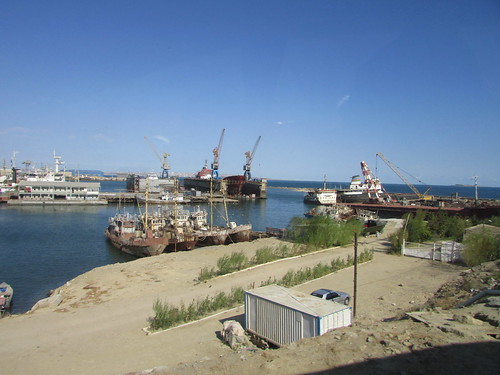
South Bay, Baku, Azerbaijan

Cargo ships laid-up in South Bay, Baku, Azerbaijan

Ocean-going tug undergoing repairs in the Floating Dry Dock 'Yusif Ibrahimov', South Bay, Baku, Azerbaijan
We passed the modern campus building of Baku Higher Oil School and then, as often occurs around Baku, we passed into a rather barren area populated only by a few 'nodding donkey' electrically-driven oil pumps, quietly extracting the source of Azerbaijan's wealth. These pump installations are more correctly called 'Pumpjacks' - there's a useful Wikipedia article here.

Pumpjacks around Baku, Azerbaijan
Equally suddenly, we were back in a modernised area with manicured lawns and the imposing Baki idman Sarayi Aquatic Palace.

Baki idman Sarayi Aquatic Palace, Baku, Azerbaijan
In keeping with any modern, capital city, Baku has equipped itself with a Contemporary Arts Centre. This is housed in one of a group of restored industrial buildings. The Yarat Centre has a website (in English) with more information here. The adjacent buildings appear to offer a variety of dining experiences.

The Yarat Contemporary Arts Centre housed in a restored former industrial building, Baku, Azerbaijan>
A little further on, a disused electricity generating station built in 1921 has been restored and re-purposed as the Heydar Aliyev Foundation's Stone Chronicle Museum (following the collapse of the Soviet Union in 1991 Heydar Aliyev was the third President of Independent Azerbaijan, succeeded on his death in 2003 by his son Ilham Aliyev who is the current President). As our coach sped by on the E119 highway, I little realised that behind the Stone Chronicle Museum, a Russian 'L' class 2-10-0 steam locomotive had been plinthed and cosmetically restored.
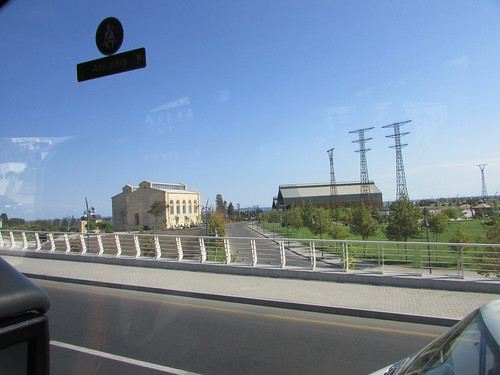
Former electricity generating station restored as the Stone Chronicle Museum, Baku, Azerbaijan. Note the disused electricity transmission towers.
We were now passing the waterfront Boulevard area with the 60 metre Ferris wheel called the Baku Eye and the not-quite-finished Caspian Waterfront Mall (there's an interesting article on the history of the Caspian Waterfront on the architect's website here).
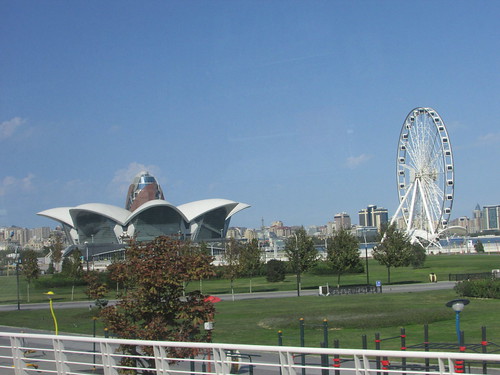
L: Almost complete Caspian Waterfront, R: Baku Eye. Baku, Azerbaijan
We passed the Azerbaijan Carpet Museum, designed to resemble a huge rolled-up carpet, then 'Mini-Venice' and the Yacht Club on our right, leaving our hotel, the Four Seasons, on our left. The coach traversed Neftchilar Avenue before turning away from the shore to continue north-east on Heydar Aliyev Avenue, passing a variety of modern buildings, some still under construction.

Around Baku, Azerbaijan
The coach continued east along the broad Airport Road before turning off into another of the strange, desolate areas around Baku of bare earth with oil derricks, pumpjacks and small capacity pipelines.
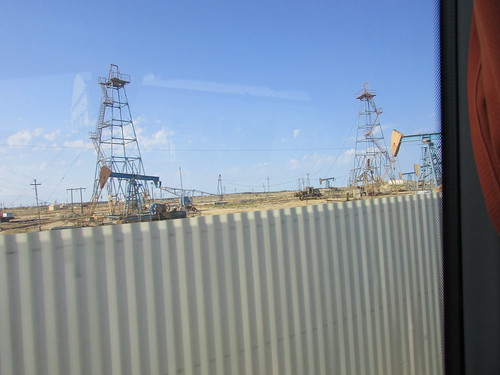
More Pumpjacks around Baku, Azerbaijan
Then we were back in a normal, suburban area, crossing a single track railway at a level crossing on the Zigh Highway before turning south-east along Balandin which took us past Surakhani station and into the coach park of the Ateshgah Zoroastrian Temple of Fire.
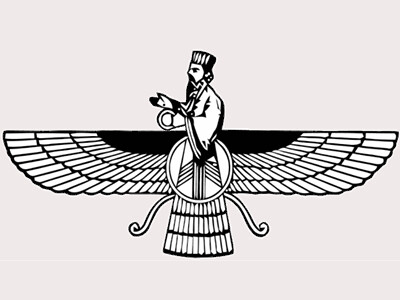
Zoroaster
Zoroaster was a Persian philosopher, prophet and spiritual leader who believed in two spiritual forces of Good and Evil with human free-will able to choose which to follow. Optimistically, he believed in the ultimate triumph of Good. He is generally thought to have lived between 1,000 and 1,500 years before the birth of Christ but this is uncertain. His thinking gave rise to the religion of Zoroastrianism which became the dominant religion in Persia.
See Zoroaster (Wikipedia) and Zoroastrianism (Wikipedia) for more.
The five-sided temple at Ateshgah has the appearance of a stone fortress, with a series of rooms and cells built into the thickness of the walls and a single access gateway, as shown in the plan below.
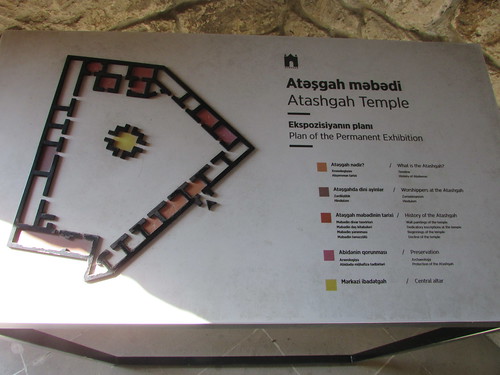
Plan of Ateshgah Zoroastrian Temple, Baku
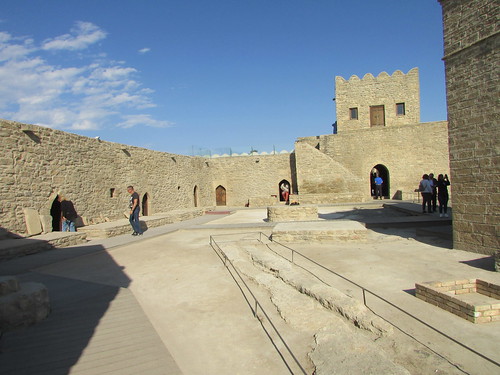
Ateshgah Zoroastrian Temple, Baku: View of inner courtyard with five doors to cells in outer wall and access gateway on right
Fire was an important symbol in Zoroastrianism and the main altar always had an 'eternal flame'. Until recently, the 'eternal flame' on the main altar at Baku was fed by a natural escape of gas but increased gas extraction rates commercially in the area resulted in connection to the gas main!
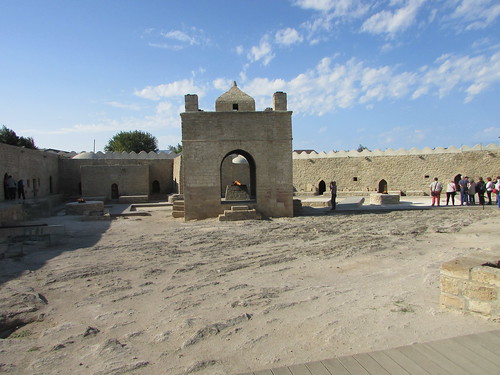
Ateshgah Zoroastrian Temple, Baku: Central altar and 'eternal flame'
Although believed to have been built during the 17th and 18th centuries for Zoroastrians, the site also became a place of worship for Hindus. The Temple of Fire is now arranged as a museum with interesting displays illustrating the life of ascetic pilgrims.
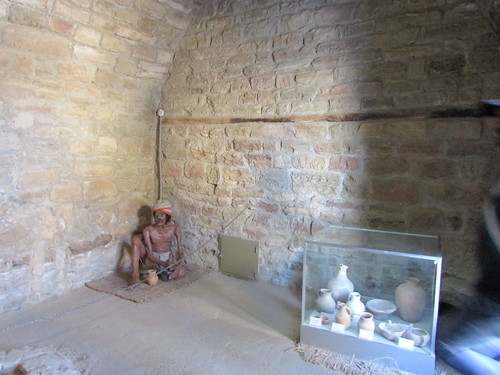
Ateshgah Zoroastrian Temple, Baku: Pilgrims' cell.
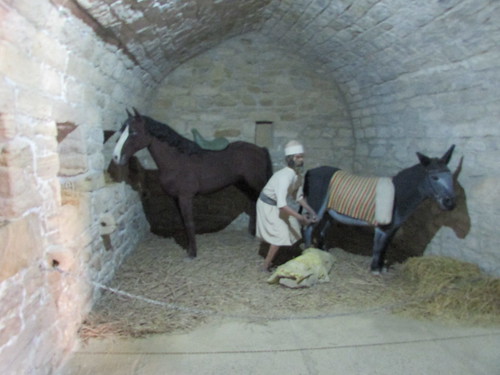
Ateshgah Zoroastrian Temple, Baku: Stable for pilgrims' horses.
See also Fire Temple of Baku (atlas obscura).
After this very worthwhile visit, it was 'back on the bus' and retrace our route to the Four Seasons Hotel in Baku, pausing briefly to admire the flowing architecture of the Zahar Hadid designed Heydar Aliyev Centre. There's more on this building on Wikipedia here.
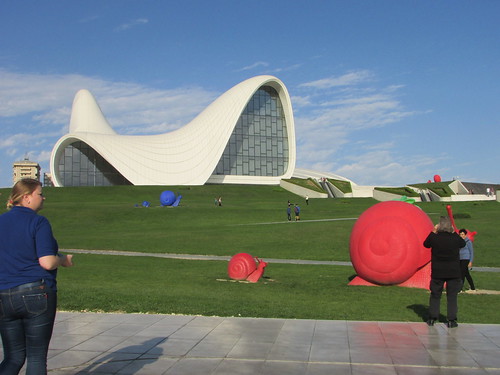
Heydar Aliyev Centre, Baku, Azerbaijan.
My 'Golden Eagle' trip was almost over - just dinner then bed because I had a very early start the following day. Dinner had been arranged for the whole party in the Mughab Club Restaurant, a few hundred yards walk from the hotel. We ate at two long tables, caravanserai-style with traditional musical entertainment provided. The meal was enjoyable but those of us with early departures the following day were happy enough to make our way over the cobblestones of the lanes leading us back to the main road, the hotel and bed after a packed day of excursions in Baku.
Related posts on this website
This is the last one of a series of posts describing my 'Golden Eagle' Caspian Odyssey trip, starting with Travelling East.
Alternately, clicking on the 'All my Caspian Odyssey reports' link displays all the posts on this trip in reverse date-of-posting order.
All my Caspian Odyssey reports.
On leaving Baku by air, I flew to Istanbul for a weekend. Clicking on the 'Next report' link below displays my first post describing Istanbul.
Next report.
My pictures
These albums include more pictures of the events described above:-
Four Seasons Hotel, Baku, Azerbaijan.
Around Baku, Azerbaijan.
The Rock Carvings of Gobustan National Park, Azerbaijan.
Ateshgah Zoroastrian Temple, Baku.
All my pictures taken in Azerbaijan (except 'technical' railway pictures) are in the collection Azerbaijan.
